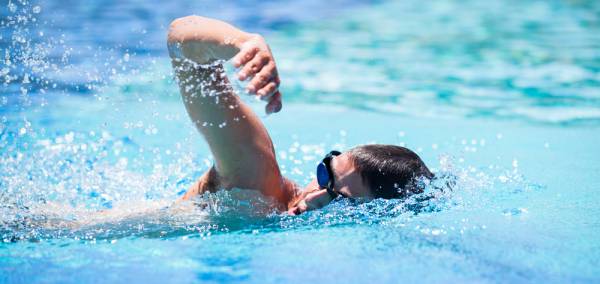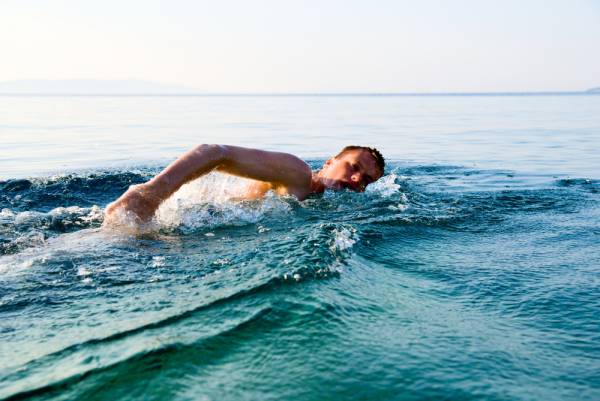Swimming is highly technical. No matter how strong and fit you are, if you don’t have the proper technique, then you won’t go fast. The best way to improve is to have a coach who gives you feedback while you swim, but by taking and observing video and thinking about your technique when you swim, you can get better on your own.
7 Swimming Tips That Count
1. Enter the Water With Your Fingers First
Your hand should cut through the water first and then your elbow should follow. Many people don’t bend their arm enough. This means the arm is straight when it enters the water, and therefore the hand and elbow enter the water at the same time. When your hand is straight, you are not able to pull the water efficiently.
2. Reach as Far as You Can With Your Arm
When your hand enters the water, you need to glide, stretch, and reach as far as you can. You can gain a few inches for every stroke, which would make a huge difference over the course of a swimming race or triathlon.
3. Place Your Hand in the Center
Your hand should not cross the centerline and it should not be too much to the outside. In fact, it should be right in line with your shoulder. If your hand crosses the centerline, you will zigzag from left to right.

4. Rotate Your Body
By rotating your body, you can reach much farther with your hands and you can use a lot more strength when pulling the water. By rotating, instead of only using your shoulder, you also use your lats muscles, pectorals, and core. It will also prevent many shoulder injuries.
“No matter how strong and fit you are, if you don’t have the proper technique, then you won’t go fast.”
5. Keep Your Hand Loose
By keeping your hand loose, you maximize the area your hand takes in the water. Don’t keep your fingers tightly pressed together because your arm will be contracted and you will lose energy.
6. Raise Your Elbows High
By raising your elbows high, your hands will enter the water with the proper angle and you will be able to pull water efficiently because your entire forearm will pull water. This also reduces the drag in the water.
7. Modify Your Kicking Cadence Depending on the Distance
For a sprint, such as 50m, 100m, or 200m, you should kick as much as you can because the event is short and you don’t need to manage your energy. For a longer event, like a 5km or 10km open water swim or an Ironman, you should kick less because you need to conserve energy. In those cases, keep a two-beat kick, which means you do one kick for every stroke.

Tips for Swimming in Open Water
If you are swimming in open water like in a triathlon, lift your head slightly but not too much to sight for the buoys. Only your eyes should be out of the water when you sight, not your mouth. After sighting, turn your head to the side to breathe. Depending if the water is choppy and on the size of the buoys, you can sight at every three to twelve strokes. In a calm lake, you can sight less often, but in choppy water, you should sight more frequently.
“Try to fix something in front of you and make sure your head stays still and doesn’t move from left to right.”
You can practice sighting by swimming laps keeping your head out of the water. Your head should stay still and your neck should be relaxed and not contracted. Try to fix something in front of you and make sure your head stays still and doesn’t move from left to right.
You need to be able to breathe on both sides so you are able to adapt to any conditions. For example, if the waves are on your left, you should breathe on your right, but if someone is swimming on your right, you should breathe on your left so you don’t swallow a lot of water.
Here’s a video describing these few tips:
Additional Exercises to Improve Your Efficiency
- Distance per stroke – Try to do as few strokes as possible for one length of the pool. Try to lower your number of strokes for one length every time you do this exercise.
- High cadence swimming – Try to move your arms quickly. It is important to be efficient when you swim, but you also need to get used to moving your arms quickly so you can swim fast.
- Swimming with a snorkel – When you swim with a snorkel, your can head remain still so you can see how your arms enter the water. Notice if your hands cross the centerline and if your fingers enter the water at the right angle.
- Swimming with a band on your feet – You can use an old bike tube, cut it and make a knot. It is similar to swimming with a pull buoy, but contrary to the pull buoy, which provides you floatability, your legs sink when you swim with a band. So, you have to strengthen your core to keep your legs still and you need to be efficient when pulling the water. You can start by swimming with a pull buoy and a band and when you feel comfortable, try without the pull.
- Do kick sets – By doing kicking sets you will become more efficient and stronger. You can use a board to work on your core strength or you can use half a board or a pull. You can also kick without anything by kicking on your back, on your sides, or on your belly (by lifting your head when you need to breathe).
More like this:
- 3 Drills for Stronger and Smoother Open Water Swimming
- Avoid These 4 Mistakes for Better Freestyle Swimming
- 3 No-Nonsense Ways to Build Fitness Through Swimming
- New on Breaking Muscle Today
Photos courtesy of Shutterstock.






